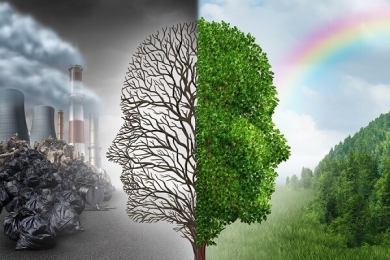Recent research on lucid dreams suggests that consciousness exists along a spectrum between sleep and waking, between hallucination and revelation, between dreamworlds and reality.

The first time it happened, it was an accident. But every dream is.
It would have been my last REM cycle of the night, had I been able to sleep. Instead, for the previous six hours, I had counted sheep, had dressed for imaginary occasions in my mind, had tried the Army sleep techniques, alternately imagined myself in a black velvet hammock and in a canoe on a calm, still lake. I’d meditated. I’d thought of my mother, a lifelong insomniac who has rarely slept more than four hours a night in her life. I’d tried everything and given up. All I could do was wait for morning.
The dream grabbed my ankles first, pulled at me like someone dislodging a drain. Out it tossed me through my sliding glass window, over the garden, over my quiet street, over the dark sleeping skyline, a ragdoll flung into the Santa Anas. I soared high enough to see Los Angeles’s motherboard of electric light. I could see the city in perfect detail below. I was asleep — no, I was awake! I felt the cold whipping through my hair as I tumbled like a deflating balloon through the sky. I felt the miles beneath me. I felt the warm pillow beneath my cheek. I dove, flew, dipped, conscious of it all.
So this is a lucid dream, I thought.
More than half of adults will have this experience or one like it at some point in their lives. They’ll go to sleep, and as their REM cycles accumulate, as night shades into morning, as their sports car turns into a banana, they will suddenly realize, as I did: This is not real. This is a dream.
The flash of lucidity can come as quite a shock, enough to startle a novice into waking. But if you can hang on and stay conscious, you’ll be in for the ride of your life.
After the first one, my curiosity was piqued. I started lurking in online forums, reading accounts of similar experiences from communities of “oneironauts,” or dream explorers. From them I learned that lucid dreams need not be a fluke experience: I could cultivate and, with some practice, control them.
The first thing I needed to do was establish a baseline awareness of the difference between waking and dreaming using a technique called “critical state testing.” This is how it works: Several times a day, ask yourself if what you are experiencing is a dream. To make sure you’re awake, count your fingers. Plug your nose. Look at your watch, then look again to see if the numbers have moved.
If you do this often enough, the habit will spill over into your dreams. And when it does, you’ll find that your fingers are jelly. That you can breathe with your nose plugged. That your watch is unreadable. “Dream standard time,” the psychophysiologist Stephen LaBerge called it in his 1990 manual, “Exploring the World of Lucid Dreaming”: asleep and awake at once.
Glimpses From The Dreamworld
Lucid dreams are as ancient as the mind. They’ve long been central to the Vajrayana Buddhist tradition, which teaches the cultivation of conscious awareness even in deep sleep. In the West, the philosophical literature of lucidity reaches back to Aristotle. René Descartes, in his first “Meditation,” famously proposed that it’s impossible to prove the difference between dreaming and wakefulness on empirical grounds alone. Friedrich Nietzsche wrote accounts of his own lucid dreams.
But in the modern sciences, the subject remained unexplored well into the 20th century. Even by the late 1970s, most scientists and psychologists believed that lucid dreams were the product of fleeting awakenings during sleep, misremembered in the morning. The very idea of conscious awareness during sleep was considered impossible to measure. After all, subjective accounts of dreamers couldn’t be quantified — how could a dreamer really know the difference between dreaming that they were conscious and actually being conscious?
Anyone who has ever had a lucid dream knows this difference intuitively, but without a measurable physiological sign, lucidity was relegated to the anecdotal, subjective experience of dreamers. That is, until someone thought to dig deeper, and look — as though lifting a veil — behind their eyelids.
In the early 1950s, a graduate student named Eugene Aserinsky hooked his 8-year-old son Armond up to a rudimentary brain-wave machine he had dragged up from the basement of a University of Chicago building. Aserinksy did not relish sleep research, at the time on the fringes of science, and the prospect of spending his nights awake, observing sleeping subjects, seemed “as exciting as warm milk.”
In the bleary morning, looking over a half-mile of polygraph paper, he despaired. The ink pens had drawn jagged lines that looked suspiciously like the saccades his son’s eyes made when they’d calibrated the machine. They showed the eye movements of a waking person. But his son had been out cold on the lab’s army cot all night. “The research project was blowing up before me,” he later recalled.
“The dream grabbed my ankles first, pulled at me like someone dislodging a drain. Out it tossed me through my sliding glass window, over the garden, over my quiet street, over the dark sleeping skyline, a ragdoll flung into the Santa Anas.”
As it turned out, there was nothing wrong with the machine. Following further study, Aserinsky discovered that his son’s sleeping brain was not — as believed by practically everyone, particularly his thesis advisor, the venerable sleep scientist Nathaniel Kleitman — simply off. Rather, brains roar to life in the darkness, in periods of active, “paradoxical” sleep that seemed to coincide with dreaming. Aserinsky considered naming the phenomenon “jerky eye movements” but, hoping to avoid being called a jerk himself, opted instead for “rapid eye movements,” or REM.
When Aserinsky left dream science behind in 1953, he passed the baton to a medical student, William C. Dement, who’d go on to establish the world’s first sleep disorders clinic at Stanford University. Years later, during a Stanford sleep study, Dement woke a subject during a period of unusually consistent back-and-forth eye movements. As LaBerge, once a student of Dement’s, recounted it, the subject had been dreaming about a ping-pong match. His eye movements during REM sleep had corresponded to his dream-gaze: left, right, left, right, following the phantom ball.
This anecdote sparked an idea in LaBerge. The study of lucid dreaming had always been stymied by its dependence on subjective self-reports. But eye movements are measurable. If a subject could deliberately move their eyes in a dream, LaBerge reasoned, then they could signal to outside observers, in real-time, that they were awake in there.
He designed an experiment around this premise, tucking a group of experienced lucid dreamers into bed at the Stanford sleep lab and asking them to make a series of prearranged eye movements the moment they became lucid. The eye measurements, unmistakable ping-pong volleys on the polygraph paper, corresponded precisely with the dreamers’ waking reports — all in the depths of REM sleep.
These “signal-verified” lucid dreams changed sleep research forever. Modern lucid dream studies rely on left-right-left-right eye signals to time-stamp experimental tasks and receive messages from the dreamworld. Lucid dreamers have been asked to signal before and after counting to 10, to measure if time unspools in dreams at the same speed as in waking life. (It does.) They’ve been tasked to signal, with their eyes alone, the answers to simple math problems piped into speakers in the sleep room to establish if two-way communication is possible between a dreamer and a waking experimenter. (It is.) Eyes, windows of the soul, open the door to dreams too.
But what is behind that door, exactly? And what is it the lucid dreamers see in there?
Alive And Mystically Beautiful
I began my critical state testing without much expectation of what it might bring. At first, I felt weird counting my fingers. Would my friends think I’d had a stroke? Had I been Reddit-brained? Was I no better than one of those people who believes life is a simulation? But the ritual was a good reminder to put down my phone. I began enjoying the blips of mindfulness it brought to my otherwise scatterbrained existence. My own hands took on the trippy quality that I remembered from being on mushrooms in college. It only took a few days for the habit to show up in my dreams.
Dreams are almost always phenomenally embodied. We look out onto the dreamscape and experience its uncanny forms and flavors largely from within an immersed, first-person perspective. Philosophers like to say that a dream is a “self-in-a-world” experience. Even as its fantastical physics support impossible actions like flying, it can never quite succeed in tearing mind from limb. You can never witness your own death in a dream, for example, because if you did, there would be no you left to dream it. As the philosopher David M. Peña-Guzmán has written, “There is no dream without a dream ego, no dream ego without a dream body, and no dream body without a dream body-image.”
But our dream bodies are only loose sketches of the real thing. When I’m awake, my hands have ink stains and nagging splinters. I have 10 fingers, and the signet ring I wear on my right hand reads “JB,” my husband’s initials. The first time I thought to examine my hands in a dream, though, they looked like a bouquet of wilting fingers. The signet ring was etched with unreadable glyphs. It’s difficult to put into words the feeling this gave me. One of the key attributes of dreams is that they feel real in the moment. When I looked at my hands and saw the mutant flippers of a Midjourney hallucination, I felt the walls drop. My whole body flushed. Nothing was real here — least of all me.
The imprecise texture of the dream-body is a marked contrast to the dream landscape, which can be extraordinarily detailed, even growing in complexity under close examination. One of the earliest written accounts of a lucid dream in medical literature, recorded by the Dutch psychiatrist Frederik van Eeden in the late 19th century, highlights this phenomenon:
I was floating through a landscape with bare trees, knowing that it was April, and I remarked that the perspective of the branches and twigs changed quite naturally. Then I made the reflection, during sleep, that my fancy would never be able to invent or to make an image as intricate as the perspective movement of little twigs seen in floating by.
“Lucid dreams are as ancient as the mind.”
In his dream, van Eeden experienced a moment of reflection as he observed the remarkable naturalness of each little branch and twig passing beneath his flying body. The trees didn’t appear to him as imprecise, or “dreamlike” — quite the opposite. He even thought to himself that such a landscape, although fantastic, must be real because there was no way his own mind could have rendered those spare branches in such detail. Such reflections are considered “pre-lucid” because they signal the dreamer’s stirring awareness — their nagging feeling that something is off.
In another classic dream report, the early 20th-century occultist and researcher Hugh Callaway recounted observing that the paving stones outside his home had changed orientation, turning parallel to the curb. This act of noticing brought the true nature of his dream into focus:
Then the solution flashed upon me: though this glorious summer morning seemed as real as it could be, I was dreaming! … Instantly, the vividness of life increased a hundred fold. Never had sea and sky and trees shone with such glamorous beauty; even the commonplace houses seemed alive and mystically beautiful.
In dreams as in waking life, attention makes the world alive. As many oneironauts have by now realized, critical state testing is not very different from mindfulness, meditation or similar practices of closely examining, sensing and being present with the world. These practices don’t only help us distinguish between waking and dreaming; they enrich our experience of both states.
In my own lucid dreams, a ripe, summer stone-fruit from the market explodes with flavor. The sensation of someone licking my belly feels wet. Pain and pleasure unfold in their phenomenal fullness. But this is always the case. The sea and sky always shine with their glamorous beauty. The world is detailed and rich. How often do I really taste a peach? How often do I take the time to examine the paving stones? Of course it’s trippy to examine my own hands: I never do it. I rarely look at anything so closely.
Higher Consciousness
As the philosophers Jennifer Windt and Thomas Metzinger have observed, we travel through our lives as “naive realists,” assuming that as we perceive, touch and taste the world, we’re interfacing directly with some external, stable reality. But in truth, all experience, including our conscious experience of selfhood, relies on input from a chaotic world and is mediated by our limited sensory organs and shaped by our subjective internal landscape. Our model of reality is, in philosophical terms, “transparent,” so convincing as to be invisible. In this sense, dreams aren’t so different from waking experience: They’re both illusions we take, falsely, to be real.
“In normal experience, we give ourselves over to the world without really questioning whether it holds at the seams or not,” explained Peña-Guzmán, whose work explores the dreaming lives of animals. “What happens in lucidity is that you begin to attend to the seams and to the cracks — you begin attending to the fact that this is a constructed space, a model, a simulation.”
The process of attending to the seams is what cognitive scientists call metacognition: the ability to think about thinking. Many philosophers believe that metacognition in dreams requires the capacity for language, since one cannot make the judgement “I am in a dream” without a subject and a predicate. But Peña-Guzmán argues that animals may be able to recognize the oddness of their dreams in a more affective and embodied way — to feel, without forming a linguistic judgement, that their world’s gone weird. As with lucidity in people, this is above all a matter of noticing.
That’s why techniques to cultivate lucid dreams, like counting fingers or examining the numbers on a clock, ask us to scrutinize the world. In people — and I sincerely hope in animals too — close attention sparks sudden clarity. This may take many forms. As Peña-Guzmán said, a dog may dream in smell, a bird in song. “Think about an electric eel that senses and produces electricity,” he said. “It’s conceivable that eel will have electric dreams, and there’s no way for us to even imagine what that is, because we don’t know what it means to experience electricity as meaningful. But they do.”
For humans, this phenomenal feast has another, more specifically cognitive flavor, too: the pleasure of awareness itself. Dreaming and waking perception are both illusory; they’re models constructed by our brains that turn sensory stimulus, or its absence, into meaning. In waking life, short of a heavy psychedelic experience, that illusion is all-encompassing; there’s no other level of consciousness to “wake up” into.
“In dreams as in waking life, attention makes the world alive.”
But in lucid dreams, we can examine the construction closely. Does this make a lucid dream more conscious than waking? Is it something, perhaps, just shy of enlightenment?
I asked the philosopher Jennifer Windt these questions when I reached her across the sleep-wake divide; as Los Angeles shaded into night, it was already the next morning in Melbourne, where Windt is senior lecturer of philosophy at Monash University. She winced. “I would struggle with that description,” she said. “I think that really assumes that consciousness can be neatly ordered in levels.” Windt is part of a school of philosophers painting a far less hierarchical, more multidimensional portrait of consciousness, one informed by close study of edge cases like out-of-body experiences, lucid dreams, mind-wanderings and hyper-realistic false awakenings.
“Traditionally, it’s been thought that not only are sleep and waking opposites, but that they impose a kind of rift, a sharp distinction between conscious states,” she explained. But recent empirical and theoretical work supports the idea that consciousness takes many forms along a spectrum between sleep and waking. Daydreams and mind-wanderings, for example, may be caused by spells of “local sleep” in the waking brain, and lucid dreams, which are linked to the reactivation of the dorsolateral prefrontal cortex — the seat of executive ego function, which is turned off during normal REM sleep — can be thought of as shades of waking consciousness in the gradient of sleep.
According to Windt’s work, a dream is an immersive, spatiotemporal hallucination, an experience of being present in a world where thoughts constitute reality. But perhaps such experiences can happen when we’re awake, too. “I think we should remain open to the possibility that if we define these states phenomenologically,” Windt said, “we might find them occurring in different behavioral states as well.”
What A Good Hologram
Every time I go to sleep, I think a new world into being and put myself at its center. I used to take this nightly miracle for granted because in dreams we all think with an immediacy and directness that leaves no room for distanced self-awareness. When the lucidity comes on, however, autobiographical memories come rushing back. I can compare the dream to waking life or to previous dreams. I can see clearly that the dream phone in my dream hand is made of Jell-O because I have access to “secondary consciousness,” or the meta-awareness of my own state.
I can’t say I’m putting that secondary consciousness to much use yet; mostly, I look for the seams. I find myself at a party in an unfamiliar house and I touch the walls, raid the fridge. What’s in there? Do the vegetables vanish when I close the door or do they have a little hoedown, like in an old cartoon? I wander into the den and turn on the TV. On the news, there’s a map of a country called “Orovno.” Did I name this country, draw this map? Borges would love this shit, I think. I ask a dream-character his name, trying to ascertain if he is, in some sense, me. He says: “Jeremy Allen White.” Ok, maybe not.
Lucidity advocates like LaBerge, who parlayed his early Stanford lucidity research into a long career as a dream guru, advise their acolytes that dream-control is a learned skill. With time, they promise, I can become a master of my dream domain, commanding characters to my will and redecorating the landscape to my tastes. I can stock my own fridge, draw my own maps, use the dream as a rehearsal space, perfect my tennis backhand, conquer my fear of public speaking. This emphasis on control and optimization doesn’t entice me much. It seems to diminish some of what makes dreams interesting to begin with — their weirdness and mystery, their associative logic.
“The thing that makes a dream exciting, at least for me, is that it’s not the waking world,” said Adam Haar Horowitz, a dream researcher and cognitive scientist who, when I reached him over Zoom at his home in rural Alaska, is fittingly curled up on his bed. Horowitz is the co-inventor of the Dormio, a dream engineering device that makes it possible to intentionally incubate specific dreams. The Dormio takes advantage of the moments between being awake and falling asleep known as the hypnagogic state; just as visions begin to form in the darkness and you sense yourself falling, the device whispers prompts into your ear, like “dream of a tree.”
Hypnagogia is when the full-fledged visions of the dreamworld begin to appear against the background of perception. As they coalesce into immersive hallucinations, they are remarkably suggestible. Horowitz’s technique involves waking sleepers at precise intervals, helping narrate the dream as it takes shape; he does so to foster creativity, treat recurrent nightmares in veterans and incubate bereavement dreams for people who have lost loved ones.
In these, he explained, lucidity would spoil the experience. Imagine sitting across the kitchen table from your deceased parent. “You don’t know it’s a dream,” Horowitz said. “That’s the beautiful thing. You’re sitting with them. Why would I want to be in a dream and know it’s a dream? I want to be in the room and want to have the conversation with the person. I don’t want to poke them and say, ‘Wow, what a good hologram.’”
“No wonder so many cultures have rituals of group dreaming.”
Horowitz finds the culture of lucid dreaming, with its emphasis on individuality and self-optimization, to be somewhat suspect. He asks me, rhetorically: What do people do in lucid dreams? They fulfill fantasies of control, seek personal thrills like flying, have sex with Jeremy Allen White.
The Dormio system is the only dream incubation tool of its type in experimental use, but there are plenty of consciousness-hacking devices on the market intended to induce lucid dreams on demand. LaBerge has developed several over the decades with names like the DreamLight and the NovaDreamer. A well-funded AI startup, Prophetic, is currently training machine learning models on EEG and fMRI lucid dream data, hoping to beam their findings via transcranial-focused ultrasound directly into willing brains; their Halo device, “the most advanced consumer neurotechnology wearable ever created,” will soon be available.
As the media scholar Aleena Chia has written, such technologies promise a “youtopia of automatized dream entertainment.” In certain sectors of Silicon Valley, lucid dreaming is talked about like virtual reality without a headset. “What a lame way to relate to your own consciousness,” said Horowitz.
Dream incubation, on the other hand, he said, “is a really holy, really humble, really hands-off tradition” with ancient roots. In classical Greek antiquity, dream-seekers traveled to dedicated temples in order to seek specific dreams of healing or guidance; after rituals of purification and supplication, they slept, communally, in sanctuaries dedicated to this purpose. As the religious scholar Kimberley C. Patton has proposed in her work, these temples were “god-haunted” places where the gods used dreams to speak between worlds. In the tradition of incubation, she has written, “Gods and human beings are the co-creators of dreams in the darkness of our mutual sleep.”
In the morning, the temple dreamers interpreted their visions with the guidance of priests. Nothing about the dream was private; it was something to be plumbed in public alongside others upon waking with the morning. The dream’s prescriptions, a cure proffered by the gods, were enacted in waking life, with the full support of the dreamers’ communities. It is from this tradition, far more ancient than Freud, that we get dream interpretation. Similar rituals of public dream incubation have existed throughout history and all over the world, in medieval Japanese Buddhism, in Shia and Sufi Islamic traditions, in Bengal, among the ancient and modern highland Maya, and in many North American Indigenous cultures.
I’ve had a few flying dreams since my first lucid dream. I’ve taken swan dives off fire escapes, soared over fields of wildflowers, been pulled into the sun itself. It can feel exhilarating to fly, to feel velocity amid total stillness. To linger in the light of an imagined sky. But it’s cold up there, too, trapped inside the dream. I can see it all, but I have nobody to share it with. No wonder so many cultures have rituals of group dreaming. No wonder they traveled far and wide to dream together, to seek succor and interpretation from oneiromantic priests. It makes the night less lonely.
By Claire L. Evans - noemamag









